AI tools are transforming industries in terms of efficiency and innovation, changing the way businesses operate, solve complex problems, and interact with customers.
From healthcare to finance, manufacturing to marketing, AI is unlocking vast potential by automating repetitive tasks, analyzing colossal amounts of data, and delivering valuable insights in real time.
So how many AI tools are there?
Let’s take a look at the numbers.
Table of Contents:
- Top AI Tools Statistics
- How Many AI Tools Are There?
- Who Are The Major Players in the AI Market?
- How Many AI Systems Are There?
- What is the Most Powerful AI?
- What is the Most Used AI Language?
- What Are the Biggest AI Models?
- What is the Smartest AI Robot?
- How Are Businesses Adopting AI Tools?
- How Will AI Tools Impact Business?
- How Will AI Tools Impact Consumers?
- What Are the Top Barriers to Adopting AI Tools?
- Conclusion
Top AI Tools Statistics
- The AI market is expected to grow from $86.9 billion in 2022 to a staggering $407 billion by 2027.
- Among AI software, hardware, and services segments, AI software accounts for the largest market size.
- The AI software market is predicted to reach $126 billion by 2025.
- China will be the world leader in AI technology by 2030, with a 26.1% global market share.
- 97% of business owners believe ChatGPT will help their business.
- 67% of consumers prefer to use AI language model tools rather than traditional search engines for finding information or answers.
Sources: Markets and Markets, Statista, Forbes, Statista, Juniper Research, PwC
How Many AI Tools Are There?
The AI market is exploding, with thousands of AI tools being added to platforms like Product Hunt daily. That makes it hard to distinguish exactly how many AI tools exist at any given moment, but the total number is probably in the hundreds of thousands.
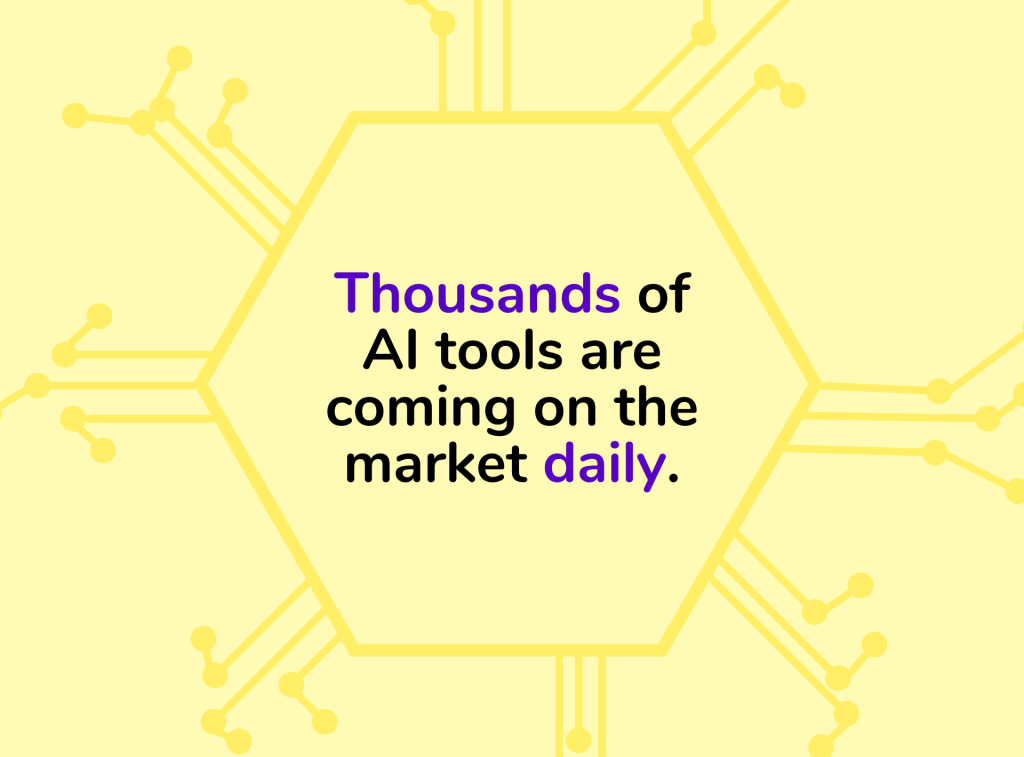
As of March 2023, there are 14,700 artificial intelligence startups in the United States alone. These businesses are centered around AI-based tools, software, and services for diverse functions like health management, payment processing, deep learning, customer management, content creation, productivity, data analytics, and more.
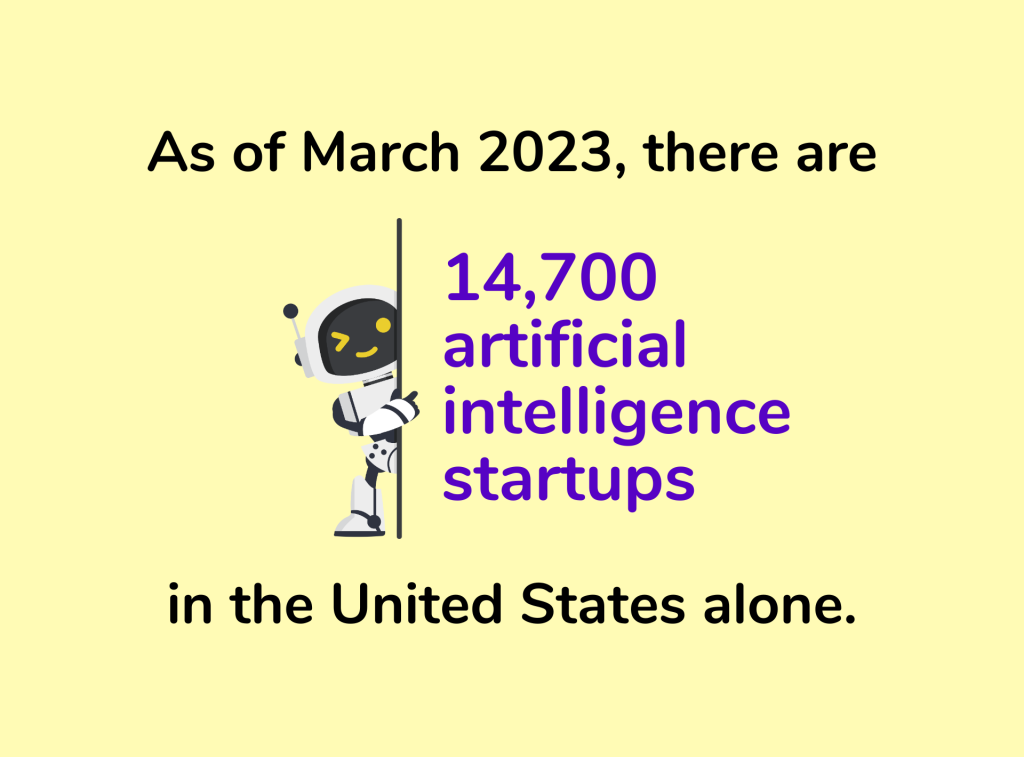
Source: Tracxn Technologies
The global AI hardware market is expected to grow from a mere $19.63 billion back in 2018 to a whopping $234.6 billion by 2025. The AI-driven hardware market includes categories such as CPU, GPU network products, and storage devices. The leading vendors are Nvidia, AMD, and Intel.
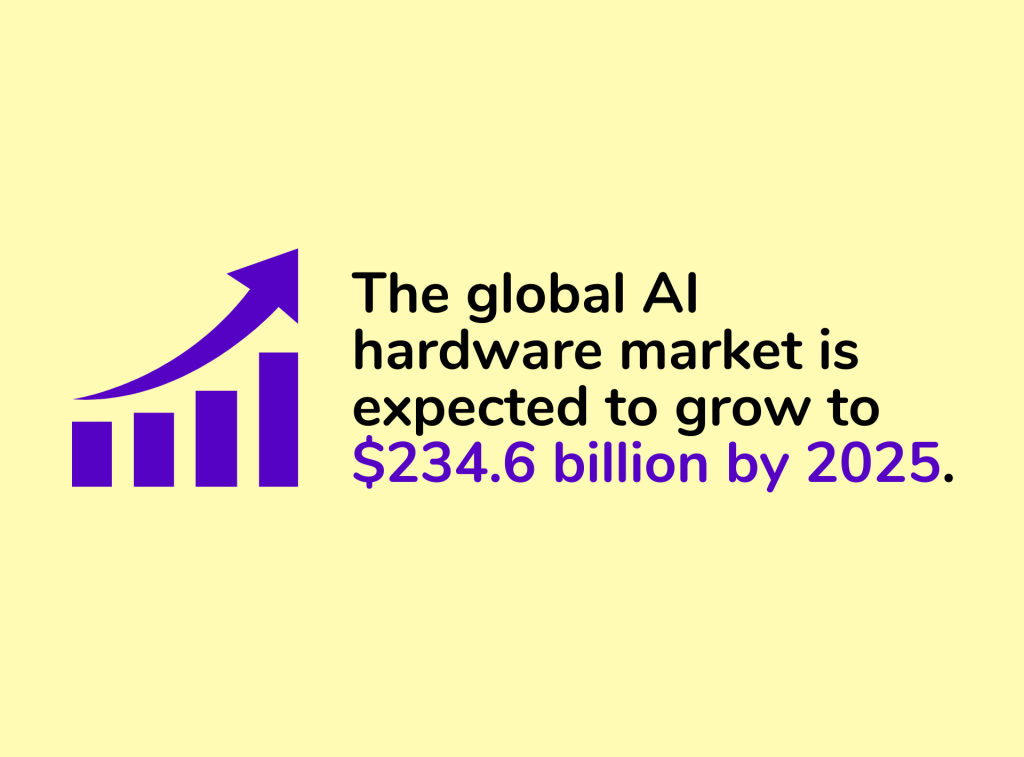
Source: Tractica
More than 4 billion devices already have AI-powered assistants, and this number is set to reach 8.4 billion by 2024.
Source: Statista
Nearly half of Americans are using digital assistants — 42% on their smartphones, 14% on a computer or tablet, and 8% on a standalone device such as Amazon Echo or Google Home.
Source: Pew Research
The chatbot market is predicted to grow from $190.8 million in 2016 to $1.25 billion by 2025,
Source: Statista
By 2022, 90% of all customer interactions will be handled by a bot — saving businesses around $8 billion per year.
Source: Juniper Research
Who Are the Major Players in the AI Market?
Along with asking how many AI tools are there, we should also consider what companies make the top of the list for AI products and services.
- Google Inc. (US)
- Microsoft Corporation (US)
- NVIDIA Corporation (US)
- Intel Corporation (US)
- Samsung Electronics Co., Ltd. (South Korea)
- IBM Corporation (US)
- Amazon Web Services, Inc. (US)
- Oracle (US)
- Meta (US)
- Salesforce (US)
- Cisco (US)
- Siemens (US)
- Huawei (China)
- SAP SE (Germany)
- SAS Institute (US)
- Baidu, Inc. (China)
- Alibaba Cloud (China)
- iFLYTEK (China)
- Hewlett Packard Enterprise Development LP (US)
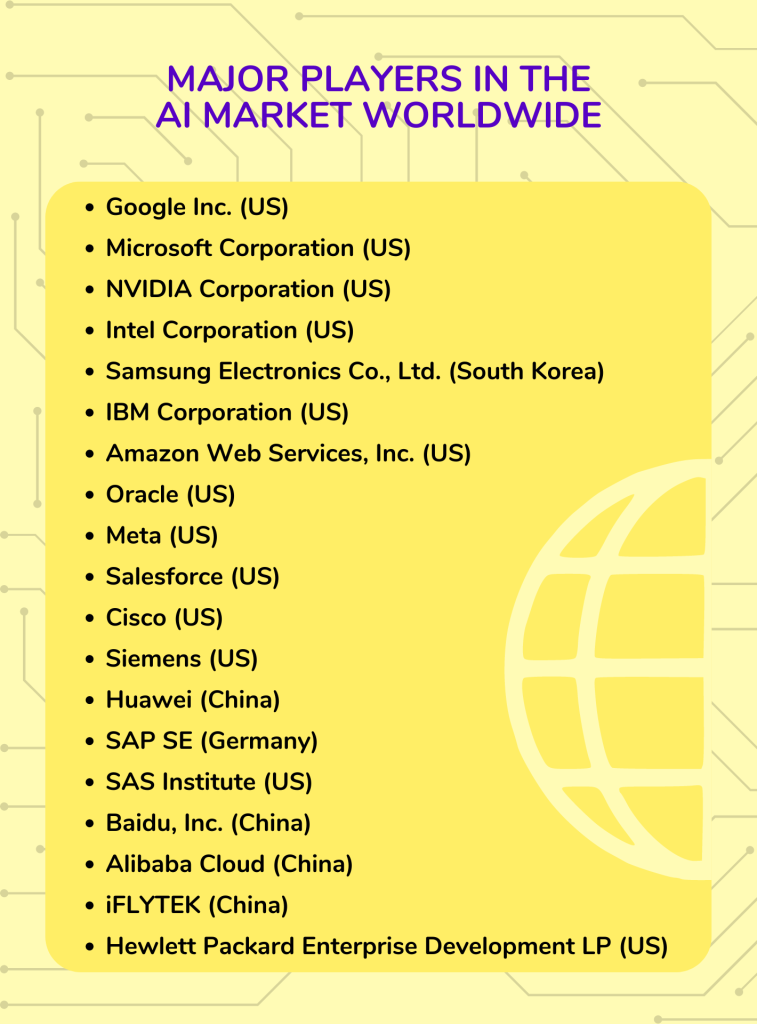
Source: Markets and Markets
How Many AI Systems Are There?
Based on how they learn and how they apply that knowledge, AI systems can be categorized into three types:
- Artificial Narrow Intelligence (ANI): Also called Weak AI, these AI tools are trained to carry out very specific commands and cannot independently learn skills beyond their purpose. Examples are virtual assistants, image recognition software, and self-driving cars.
- Artificial General Intelligence (AGI): Also called Deep AI, these AI tools are able to learn and think almost like humans. Examples are supercomputers and generative AI models like ChatGPT.
- Artificial Super Intelligence (ASI): The highest level of AI, this is the stuff that science fiction is made of. These AI tools are theoretically smarter than humans.
Source: BuiltIn
What is the Most Powerful AI?
GPT-3 (OpenAI): Designed to generate human-like responses, GPT-3 has 175 billion parameters and shows impressive abilities in various language tasks.
GPT-4 (OpenAI): The latest iteration of the GPT series, GPT-4 has 100 trillion parameters and can process up to 25,000 words at once — 8x the capability of GPT-3.
Watson (IBM): This advanced AI software can interpret text documents and identify patterns that are almost impossible for humans to detect. Watson is also capable of reasoning, making hypotheses, and learning feedback. It particularly excels in the healthcare industry with its ability to predict skin cancers just from an image of a patient and detect diseases like cardiovascular disease and cancers with impressive accuracy.
Sophia (Hanson Robotics): Sophia is a humanoid robot designed to interact with humans using facial expressions, gestures, speech synthesis, emotional stimulation, and natural language processing. She made history in 2017 when Saudi Arabia granted her citizenship — the first of her kind.
AlphaGo (Google DeepMind): Designed to play the Chinese board game Go, this technology landed in magazines when it beat Lee Sedol, the reigning world champion. AlphaGo is trained on a large corpus of human Go games and fine-tuned with Deep Reinforcement Learning.
Tesla Autopilot (Tesla): The technology behind Tesla’s self-driving cars, Tesla Autopilot is a smart AI system that uses cameras, radar, ultrasonic sensors, and GPS to drive and park a vehicle without human intervention. It can also detect road accidents with 90-95% accuracy.
Source: Litslink
What is the Most Used AI Language?
According to the University of California, Berkeley, the most widely used and desired programming languages for artificial intelligence are:
- Python
- Java
- C++
- JavaScript
- Julia
- LISP
Source: Berkeley Coding Boot Camp
What Are the Biggest AI Models?
Large language models (LLM) are computer programs that are trained to analyze vast amounts of textual data in order to predict word sequences, which enhances their ability to generate text. Language models serve as the basis for numerous natural language processing (NLP) applications, including speech-to-text conversion and sentiment analysis.
Some of the biggest AI models are:
OpenAI
- GPT-3
- GPT-4
- LaMDA
- Bard
- BERT
- PaLM
- mT5
DeepMind
- Gopher
- AlphaFold
- Gato
- Chinchilla
- Sparrow
Meta
- LLaMa
- ESMFold
- OPT-IML
- BlenderBot-3
AI21 Labs
- Jurassic-1
Microsoft/Nvidia
- Megatron-Turing NLG
LG AI Research
- Exaone
Anthropic
- Claude
Hugging Face
- BLOOM
Baidu
- Ernie 3.0 Titan
- Ernie Bot
Huawei
- PanGu-Alpha
Sources: MarkTechPost, AI Business
What is the Smartest AI Robot?
Humanoid robots resemble the human body. They are designed to interact with human tools and customer service. The most advanced robots are able to talk like humans, walk like humans, and even express emotions.
Applications of humanoid robots include education, personal assistance, manufacturing, search and rescue, healthcare, entertainment, and more.
Here are 5 of the smartest AI robots in the world.
- Sophia by Hanson Robotics
- Asimo by Honda
- Atlas by Boston Dynamics
- Ameca by Engineered Arts
- Nadine by Kokoro
Sources: Forbes, ResearchGate, Honda, Boston Dynamics, Engineered Arts
How Are Businesses Adopting AI Tools?
Close to 80% of businesses are using or exploring AI. Among them, 35% have already adopted AI into their operations while 42% are planning to implement it in the future.
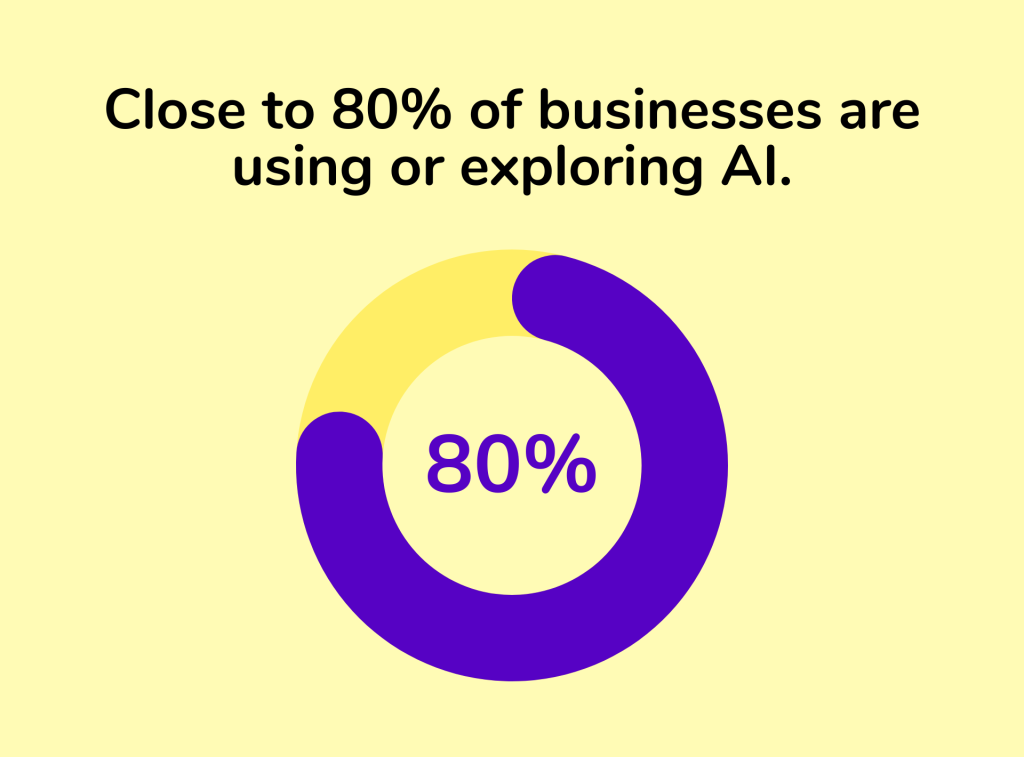
Let’s look at how companies from different industries are adopting AI tools.
- 58% of B2B companies and 42% of B2C companies use chatbots.
- IDC analysts predict that financial services companies will spend $11 billion on AI tools to prevent fraud, streamline underwriting, and improve overall customer experience.
- 66% of leading global financial firms have adopted a chatbot to help customers with online transactions.
- AI in retail is expected to grow from $4.84 billion in 2021 to $31.18 billion by 2028.
- 73% of retailers plan to use AI to determine prices based on rising costs and seasonal demand.
- 75% of retailers plan to adopt AI tools to reduce credit card fraud.
- Amazon reduced its click-to-ship time by 225% — down from 75 minutes to just 15 minutes — thanks to robots automating its packing process.
- Netflix saved $1 billion in canceled subscriptions by using machine learning.
- The chatbot market in the healthcare industry is forecast to surpass $543 million by 2027.
- Heliograf wrote more than 850 stories on the Rio Olympics for The Washington Post.
- 70% of light-duty vehicles and trucks will be connected to the Internet by 2023.
- AI will take over 10% of nursing duties by 2030.
- In the travel and hospitality sector, 25% of businesses are already using chatbots to handle general inquiries and bookings, while 46% are planning to adopt the technology in the future.
Sources: IBM, Fortune Business Insights, EMB, AIIOT, McKinsey, Forbes, The Washington Post, Statista, EIT Health, Statista, OvationCXM, Forrester, Market Research Future
How Will AI Tools Impact Business?
Businesses are excited about the enormous potential of AI to reduce their labor costs and increase productivity. But along with these benefits are concerns over technology dependence and the learning curve that comes with AI adoption.

- 97% of business owners believe ChatGPT will benefit their business.
- In 2022, businesses saved a total of $11 billion just by adopting chatbots.
- Businesses can save up to 30% on customer support costs alone by using chatbots.
- 55% of businesses that use chatbots generate more high-quality leads.
- Chatbots can increase website conversions by up to 100%.
- Upselling chatbots have a 20% conversion rate.
- 30% plan to use ChatGPT to write website content.
- 44% plan to generate content in multiple languages.
- 64% believe AI will enhance customer relationships.
- 64% believe AI will increase business productivity
- 42% believe AI will streamline job processes.
- 43% are concerned about technology dependence
- 35% worry about not having the technical skills to use AI effectively.
- 27% of business executives plan to invest in AI cybersecurity safeguards to defend against cyber attacks.
Sources: Forbes, PwC, IBM, Drift, Leadoo, Tidio
How Will AI Tools Impact Consumers?
With the explosion of AI tools like ChatGPT and Dall-E, there is a growing inclination among consumers to use AI instead of traditional means for interacting with information online.
- 88% of consumers have had at least one conversation with a chatbot.
- Around 1.5 billion people worldwide are using chatbots, and most of them are in the United States, India, Germany, the United Kingdom, and Brazil.
- 67% of consumers would rather ask questions and find information through ChatGPT than Google.
- 67% of consumers expect to talk to a business through live chat.
- 62% of consumers would rather talk to a chatbot than wait for a human agent.
- 90% of customer queries are resolved by a chatbot in 10 or fewer messages.
- 54% believe AI can improve website content.
- 46% of Americans use digital voice assistants.
- 53% believe chatbots have improved customer experience.
- 75% are concerned about misinformation from AI tools.
How are they using AI tools for everyday tasks?
- 45% use AI to respond via text or email.
- 43% use AI to answer financial questions.
- 38% use AI to plan a travel itinerary.
- 31% use AI to write an email.
- 30% use AI to prepare for a job interview.
- 25% use AI to write social media posts.
- 19% use AI to summarize long-form, complex text.
- 71% talk to a chatbot to check the status of their orders
- 67% use a chatbot to search for products
- 62% use a chatbot to search for deals and discounts
- 59% talk to a chatbot to order food
- 58% talk to a chatbot to book a meeting
- 54% use AI to make a payment
- 46% talk to a chatbot to return a product
- 40% talk to a chatbot for troubleshooting
- 28% talk to a chatbot to complain about a product or service
Sources: Forbes, Pew Research Center, Chatbots Magazine, Tidio
What Are the Top Barriers to Adopting AI Tools?
Businesses can face a myriad of challenges when considering the adoption of new technology. Here are some of the top barriers to implementing artificial technology in the workplace:
- 56% lack of personnel skills
- 42% inability to understand AI benefits and uses
- 34% data scope or quality
- 26% integration complexity
- 26% finding use cases
- 25% defining a strategy
- 20% security or privacy concerns
- 13% governance concerns
- 12% lack of funding
- 10% confusion over vendor capabilities
Source: Gartner
What Industries Will Survive AI?
Artificial intelligence will continue to radically transform the workforce.
- Robots, artificial intelligence (AI), machine learning, and automation will replace 7% of US jobs by 2025.
- The biggest disruptions will happen in the area of office and administrative support.
- At the same time, AI will create new jobs such as data scientists, content curators, and robot monitoring professionals — which could mean 8.9 million new hires by 2025.
- 93% of automation technologists feel unprepared or only partially prepared to tackle the challenges associated with smart machine technologies.
Source: Forrester
All is not gloom and doom once AI sweeps through the job market. Forbes tech experts predict that these industries will survive the AI onslaught:
- Logistics
- Healthcare
- Education
- Agriculture
- Financial Services
- Marketing and Advertising
- Human Resources
- Energy
- Construction
- Public Transportation
- Media and Entertainment
How Many AI Tools Are There? The Number is Exploding — and Transforming Industries
The rise of AI has transformed industries like we’ve never seen before. As technology continues to evolve, the number of AI tools will continue to rise — bringing increased automation, personalization, and efficiency into our daily routines.
Embracing these advancements, we can unlock new levels of productivity, convenience, and innovation, ultimately creating a world where AI tools work hand in hand with humans to make our lives better.